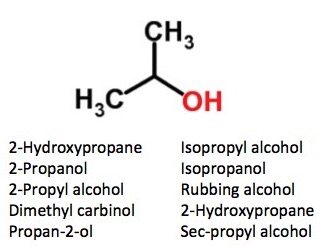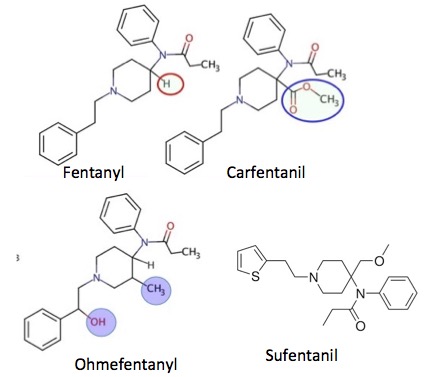It's more than a bit ironic that nine months after I wrote about how the Kolodny Klan was using misleading words (and numbers) to promote their version of the fake opioid crisis (See The Opioid Epidemic In 6 Charts Designed To Deceive You) that some of the pain patients who are fighting back are doing the same things, albeit, unintentionally. Let's fix this.
ORGANIC CHEMISTRY NOMENCLATURE IS MADNESS
For most people, chemistry is difficult enough, but when you toss in nomenclature, logic becomes illogical. There are multiple ways to name almost all chemicals. It is not rare to see a dozen different names for the same compound, some of which make sense and others are bewildering. As in Figure 1.

Figure 1. 10 different names for rubbing alcohol - all correct (1) (See Putrescine And Cadaverine: Two Chemicals That Earned Their Names )
So it should not be the least bit surprising that the terminology of the "fentanyl epidemic" (2) is being mangled. Let's unmangle it.
FENTANYL IS FENTANYL
Fentanyl is a single chemical with a unique molecular structure. It has a bazillion different names but they all refer to the structure below.

So, no matter how its made or where it comes from, fentanyl is fentanyl. But, it's not quite that simple.
FORMULATION MAKES A BIG DIFFERENCE
The properties of a drug can be drastically altered by how that drug is formulated. The simplest example is immediate-release vs. extended-release. The terms are self-explanatory. Extended-release drugs often have advantages over their immediate-release versions (3).
Pharmaceutical (legal) fentanyl comes in a variety of forms, some are immediate-release and others are extended-release (4). Some examples:
- Durogesic aka Duragesic (patch, extended-release)
- Actiq (lozenge, immediate-release)
- Abstral (sublingual, immediate-release)
- Effentora (buccal, immediate) (5)
- Instanyl (nasal spray, immediate-release)
WHY THE NAME CONFUSION? FENTANYL VS. ILLICIT FENTANYL
I don't really know. It is quite possible that the confusion was intentionally created by the CDC, just like it did by lumping all opioids together, giving the impression that pills were killing 64,000 people per year, even though this is undeniably false. But this one is really simple. Here are the correct definitions for the two terms that are creating confusion at this time.
Pharmaceutical vs. Illicit Fentanyl
Pharmaceutical fentanyl is made legally by drug companies using FDA standards that apply to all other prescription drugs- safety, purity, potency, dose, etc. Pharmaceutical fentanyl is not a significant contributor to the number of OD death. Illicit fentanyl, mostly from Chinese labs, is. But it is the exact same drug (6) as that found in pharmaceutical fentanyl but in a different form. Illicit fentanyl is a white powder contaminated with god-knows-what. It is immediate-release and this is why it is killing people. A lethal dose is 1-2 mg, so even a small weighing or mixing error can lead to a fatal overdose.
Even though they are the same drug, illicit fentanyl is far more dangerous than pharmaceutical because of its unknown composition and dose. And the confusion gets worse, which is responsible for the second bit of misinformation that is now going around - illicit fentanyl vs. fentanyl analogs.
MORE CONFUSION - FENTANYL VS. FENTANYL ANALOGS
As if unknown doses of street fentanyl aren't bad enough, it isn't only fentanyl that is killing people. Fentanyl analogs (7) are far more dangerous because there are about a dozen of them circulating around the US and most of these are far worse than fentanyl itself. These are different drugs. They are not fentanyl. (See: If You Think Fentanyl Is Bad... )

Fentanyl and three analogs. All three are far more potent than fentanyl.
So, it is incorrect to call carfentanil fentanyl. Carfentanil is a drug which is a member of the fentanyl family but it is not fentanyl. It is structurally different and much more dangerous. Do not equate illicit fentanyl analogs with fentanyl. This is inaccurate.
So, let's keep our terms straight, especially since the CDC and other zealots do not. There are already plenty of screw-ups running around. Don't become one of them.
NOTES:
(1) It gets even worse. Ethanol, which is also called rubbing alcohol, has about 10 names of its own.
(2) As I have written many times in the past the term "opioid epidemic" is contrived and misleading. There is no opioid epidemic. What we are going through is a "fentanyl epidemic."
(3) But not always. Extended-release drugs give steady blood levels, which is usually beneficial. But if you have had painful oral surgery and the Novocaine is starting to wear off you're going to want Percocet, not Oxycontin, even though they contain the same drug oxycodone.
(4) An intravenous combination of fentanyl, propofol and a benzodiazepine is used for induction and maintenance of general anesthesia.
(5) Buccal means putting the drug between your cheek and gums. It is similar to sublingual (under the tongue).
(6) It may be the same drug but it will not have the same purity. In fact, the profiles of impurities can be used to determine where the illegal drug came from. (See: Fentanyl Sleuthing Gives Hints About Where It's Made - Sometimes)
(7) Analogs are close chemical cousins, but they are always different in chemical structure and properties. Sometimes even minor changes in structure can make an enormous difference in potency. Sometimes it is inconsequential.




